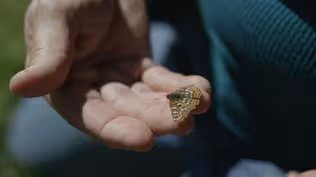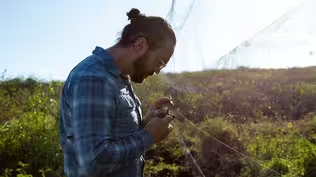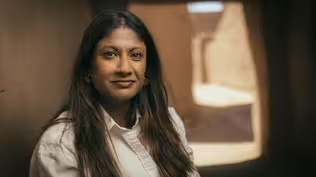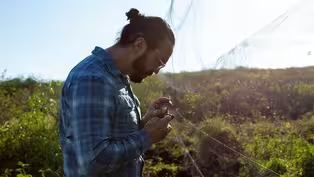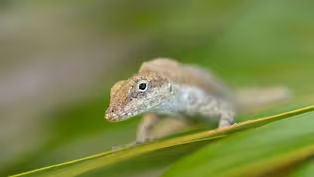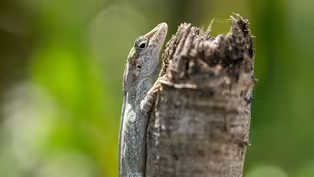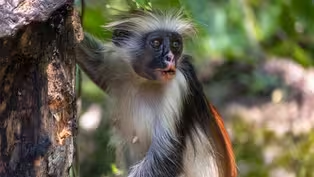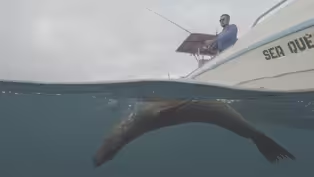
Islands
Episode 2 | 55m 26sVideo has Closed Captions
Remarkable island wildlife reveals insights into our rapidly changing planet.
Islands are like miniature simplified Earths, where evolution is playing out at super speed right before our eyes. Journey from the Galapagos to the edge of Antarctica to seek out animals responding to our changing planet in extraordinary ways.
Problems playing video? | Closed Captioning Feedback
Problems playing video? | Closed Captioning Feedback

Islands
Episode 2 | 55m 26sVideo has Closed Captions
Islands are like miniature simplified Earths, where evolution is playing out at super speed right before our eyes. Journey from the Galapagos to the edge of Antarctica to seek out animals responding to our changing planet in extraordinary ways.
Problems playing video? | Closed Captioning Feedback
How to Watch Evolution Earth
Evolution Earth is available to stream on pbs.org and the free PBS App, available on iPhone, Apple TV, Android TV, Android smartphones, Amazon Fire TV, Amazon Fire Tablet, Roku, Samsung Smart TV, and Vizio.
Buy Now

Evolution Earth
Traveling to the far corners of the world, we discover the extraordinary ways animals are adapting to our rapidly changing planet. We witness nature’s remarkable resilience, as our perception of evolution and its potential is forever transformed. Read these interviews with experts to learn more.Providing Support for PBS.org
Learn Moreabout PBS online sponsorship[Animals chattering] [Campbell-Staton] Islands are laboratories of life... places to see evolution in action.
[Rustling] On the most famous island laboratory of them all, Charles Darwin, or Chuck D, as I like to call him, got his first glimpses of how changes in the environment shape life.
And those animals are continuing to change... updating our understanding of what evolution means in the 21st century.
[Water bubbling] [Upbeat theme music playing] ♪ ♪ My name's Shane Campbell-Staton.
I'm an evolutionary biologist.
I'm here to tell you stories from filmmakers, scientists, and local experts across the globe about a pulse of change.
The entire planet is shifting.
The climate is changing at an incredible 170 times faster than it should be.
We can't always see it.
We're so caught up in our own thing.
You know?
But the signs are everywhere.
♪ The entire tree of life is whispering to us.
[Water splashing] We just have to pay attention.
[Snorting] Out there, things aren't what you expect.
You'll see.
♪ For an evolutionary biologist like me, nowhere on the planet can be more special than the Galapagos.
This is Nirvana.
Recently, we'd heard of signs of change etched in the ocean... reports of crazy activity in remote coves... predators behaving in unexpected ways.
El 06:00 nos levantamos... y los lobos "Auu auu auu" gritaban "Kshh kshh kshh."
[Splashing] [Man] Oh, qué pasa?
Qué pasa?
[Splashing] [Campbell-Staton] Sea lions are hunting in a way seen nowhere else in the world.
[Man] Una locura.
[Campbell-Staton] On the trail of this mysterious behavior, we caught up with local fisherman Franklin Arreaga who thinks he knows what's going on.
Ah ha.
Estoy pensando...ha ha ha!
Atacaban los lobos, los lobos cogían, seguian, seguian las albacoras.
[Campbell-Staton] Sea lions hunting tuna.
Now, that's not normal.
Franklin should know.
He spends his whole life fishing these waters.
[Franklin] La pesquería ha estado dentro de mi familia hace 50 años.
Yo pesco de los 14, 15 años.
[Campbell-Staton] Oh, wow!
Yeah.
That is definitely a big tuna.
[Franklin] Es mi vida, mi pasión, mi todo.
[Campbell-Staton] Franklin says he can take us to a secret cove to try and see the sea lion hunting in action.
♪ But there are no guarantees.
[Chain rattling] You just have to wait.
[Rattling] Time for a one-on-one chat on the state of our changing planet.
[Franklin] Antes había bastante abundancia.
Eh, hace unos 15 o 20 años se pescaban, se pescaba cerca de puerto.
[Line unraveling, splashing] Ahora tenemos que correr más lejos.
[Campbell-Staton] Up to 8 hours further... [Birds calling] something Franklin puts squarely at the feet of the industrial fishing fleets just outside Galapagos' waters.
He may be right.
90% of all global fish stocks are over-fished or completely depleted.
Don't just take Franklin's word for it.
The sea lions are also having a harder time finding fish... so much so, they are changing.
Normally, sea lions hunt sardines... but with fish stocks crashing, some are switching to a new prey... something 300 times bigger-- Franklin's tuna.
And he told us they aren't just hunting a new fish.
They're taking them down in a whole new way.
But, the wait was so long, we were beginning to wonder if this was just a fisherman's tale.
♪ Then, finally... the sea lions arrive... on the hunt.
[Splashing] And, instead of chasing the tuna out in the open water... they corral them towards the shallows.
[Franklin] Ahora vienen todos lobos saltando como delfines a traer el atún... y tratar de encaminarlas a la poza.
♪ [Campbell-Staton] Tuna are some of the fastest fish on the planet, 4 times faster than the sea lions.
[Franklin] Son como un misil en el agua.
♪ [Campbell-Staton] So, the sea lions start to do something else new.
[Water bubbling] Normally, they hunt on their own, but now they play as a team.
It's like they're saying, "You go on the attack, and I'll hold down the defense."
A chaser drives the fish towards a dead end, but the fish turns to open ocean.
Blockers move in and cut off the escape.
[Sea gulls crying] ♪ Now the sea lions close the trap.
♪ The water is getting shallower and shallower.
[Sea lion grunting] The tuna are out of their depth.
As the fish tire, the sea lions move in for the kill.
♪ ♪ ♪ [Sea lion grunting] ♪ [Sea lion grunting] If you want to get all evolutionary about it, well, hunting as a team is socialization.
[Sea lion grunting] It shows the emergence of a new culture, underwater, in real time.
[Splashing] Any way you cut it, that's something very special.
It's a behavior new to science: animals changing in response to a new world order.
As the environment shifts 10 times faster than in the last 65 million years, the question is: Can life keep up with the pace of change?
[Bird calling] [Splashing] Well, there are new discoveries about that, too... [Splashing] with a much more famous Galapagos resident.
[Splashing] It's a giant in my world... [Chirping] the finch.
♪ [Campbell-Staton] It was finches like this that cemented my man Chuck D's revolutionary theory of how animals change over time, how we all got to be who we are.
The incredible thing is, now they're doing it all over again.
Darwin showed that one kind of finch, isolated on different islands, can change into different kinds of finch with different kinds of beak... You have a beak for seeds... [Chirping] a beak for flowers... a beak for bugs... Aw, yeah!
[Chuckling] even a beak for blood.
Each beak adapted to the conditions of each island over millions of years.
"Survival of the fittest," as they say.
[Wings flapping] This isn't just a change in behavior.
It's an evolution of their physical form.
So far so good, but research is now showing that Darwin had one aspect of this story all wrong.
♪ For 50 years, biologists have been capturing and recording Darwin's finches in every minute detail, and they've revealed something that would amaze Darwin-- the speed of change.
[Birds chirping] This is the guy to tell us all about it, one of the latest to dedicate their life to the birds-- local scientist Jaime Chaves.
[Jaime] For any evolutionary biologist to have even the chance to be on the Galapagos to study finches is kind of a gift.
[Campbell-Staton] Speaking to him, it's hard not feel a little jealous.
[Jaime] I'm just amazed by the amount of data that these little birds have been producing.
[Campbell-Staton] Nothing like a bit of data.
[Jaime] The difference between these two birds is the beak sizes.
So, this bird on the right-hand side has a smaller beak compared to this one on my left, although being both from the same species.
[Campbell-Staton] These tiny variations can mean the difference between life and death.
[Jaime] Almost 1 millimeter in beak length.
That maybe doesn't sound too big, but a dramatic environmental event can wipe out half of the population, because those birds didn't have the beak shape to respond to that dramatic change.
[Campbell-Staton] You don't need a whole different island for evolution to take place.
The data now show that all it takes is a big enough driving force, like a severe drought, and beak shapes can change almost overnight.
[Jaime] Evolution on the Galapagos is actually very fast.
We can actually measure how much evolution can happen between year 1 and year 2.
[Campbell-Staton] So, there you have it.
Chuck had it not quite right.
It turns out, a biological change can happen in a matter of just years, not millions of years like he thought.
You know, that's a radical shift.
And amazingly, biologists like Jaime are getting to watch it unfold before their very eyes.
And Jaime's got a twist to the story.
He's now tracking how we humans can be the driving force.
The growth of towns in the Galapagos means new food sources.
[Dishes clattering] [People talking indistinctly] And right on cue, finch beaks are changing again.
[Jaime] Now human food is acting as a new force.
And you have small beaks, medium beaks, and even larger beaks all together in this blend of this urban finch.
[Chirping] What Jaime's seeing is that with all this fast-food lying around, there's no need to be a specialist.
Now any beak shape goes.
And in some places, this is even leading to a twist in evolution.
Finches that were once evolving into separate species are now breeding and thriving together, 2 species merging back into 1, which you might call a, uh, an evolutionary U-turn.
What we're learning here in the Galapagos Islands is animals have a far greater ability to adapt to a changing world than we thought.
And, you know, it's not just here.
Stories of extreme evolution are popping up on islands everywhere.
We got an inside tip about a discovery in the Caribbean that's changing the textbooks.
Of all the stories in this series, this one's one of my personal favorites because my obsession is lizards.
♪ Back in 2017, it's hurricane season.
And no one knows it yet, but weeks from now 2 category 5 storms will rip through the islands.
It's the perfect set-up to discover something wild.
All you need is the right person in the right place at the right time.
I'll probably walk a little bit behind the pile, where the palmetto trees are.
That's a good area.
[Campbell-Staton] You're the expert, my man.
Lead the way.
All right.
[Campbell-Staton] Like me, Anthony Herrel is into lizards in a big way.
[Anthony] I mean, I'm probably among the few people in the world that know quite a bit about lizards.
So, I would say I'm a lizard expert.
[Campbell-Staton] Getting to catch up with Anthony is pretty cool.
He actually took me on my very first field trip back when I was an undergrad student.
And you might think tracking down lizards in the undergrowth is kind of weird, and maybe it is, but it still gets me fired up.
[Animal squeaking] Anthony is looking for a very special population of the tiny lizards... with a surprisingly big story to tell.
Silver Key anoles only live on a few islands out here.
They rely on grip and speed as they compete for food... [Buzzing] and a mate.
♪ ♪ ♪ ♪ There's one over there.
Do you guys want to check it out?
It's on the top of that frond.
[Campbell-Staton] These lizards are highly territorial.
Whichever of these two guys holds on to the top spot is more likely to get the girl.
Now, I could watch this all day... [Anole drops to ground] but Anthony's not here to watch fights.
He's here to catch lizards.
And I can tell you, it's harder than it looks.
[Palm fronds rustling] Anthony's completing what we scientists call a "baseline" study.
[Anthony] Come on, my friend.
[Campbell-Staton] And pay attention in the back... because all this lizard data is going to be important.
Come on, little guy.
With expert handling, this doesn't hurt them at all.
Just by generally looking at it, we can see that this is a male here about 3 years of age.
And then on each toe, you actually have these sticky toepads that-- Gotcha.
And as you can see they're pretty fast, um, trying to get away.
And so, these measurements will basically allow us to look at populations and how they change through time and evolve as the environment is changing.
[Campbell-Staton] As luck would have it, Anthony heads home just as two massive storms are brewing out at sea... [Winds whipping] Hurricanes Irma... [Thunder booming] and Maria.
[Lightning crackling] [Raining] [Man on TV] The eye of Irma is right now moving through the Turks and Caicos Islands.
Maximum sustained winds are potentially catastrophic-- 175 miles per hour.
[Wind blowing, thundering] [Campbell-Staton] Both storms tear the islands apart.
[Cracking, glass breaking] ♪ [Dripping, rain slowing] Anthony wonders: Can his lizards possibly keep up with this kind of destructive change?
[Anthony] So, I contacted one of the leading experts in the field, and he basically was like very skeptical.
He said, like, "Oh, I don't think you'll find anything.
"The lizards probably are all going to be dead anyways, so why do you really want to go back?"
[Airplane flying] [Campbell-Staton] Anthony is desperate to find out, so, he returns.
And he's shocked by what he finds.
♪ The average lizard now has bigger feet and longer front legs.
More than that, when he carries on the study, he finds the lizards pass these traits on to their young.
They're evolving into "Hurricane Lizards."
To find out what was going on, Anthony tells me he even re-creates a hurricane... [Loud whooshing] with a leaf-blower.
[Anthony] We had expected that they would just jump off, um, get away from the wind, but they didn't.
They actually went to the backside of the branch.
♪ [Loud whooshing] ♪ [Campbell-Staton] You can see why those bigger feet and longer legs make a difference.
[Anthony] The big toe pads allow you to stick really well onto that branch that you're holding onto.
And the forearms allow you to really grip around the branch.
[Campbell-Staton] Surprisingly, the newly evolved hurricane lizards even have different aerodynamics.
Amazing what we biologists will do in the name of science.
All Anthony's work shows that evolution can take place at an incredible speed, even faster than with our finches in the Galapagos.
[Anthony] The fact that 2 hurricanes changed the morphology of the entire population, shifting their shape, is really quite amazing.
[Campbell-Staton] The hurricanes were what we biologists call selective events.
We now know that the kind of evolutionary change that Darwin thought happened over millions of years can be triggered by a single catastrophic storm.
And on a warming planet, where extreme hurricanes are predicted to increase by 13% in the next 40 years, it's good to know some of the inhabitants here can handle themselves.
♪ Cut off for millions of years, islands are closed ecosystems.
That's what makes them such amazing laboratories to study evolution, but this isolation also makes islands vulnerable... because when we humans arrive, we bridge the gap... connecting an island to the rest of the world... [Whooshing] and presenting it with its greatest threat: alien invasion.
[Airplane whooshing] [Birds chirping] New species introduced to the Hawai'ian archipelago have out-competed and killed so many animals and plants here that Hawai'i is called "The extinction capital of the world."
[Crickets chirping, buzzing] ♪ One of the latest alien invaders... a deadly parasitic fly.
This female is on the hunt for a host.
Her target: the Pacific Field Cricket.
[Cricket chirping] At night, male crickets sing to attract a mate by rubbing their wings together.
The alien fly listens in on the same song.
In the darkness, she uses the sound to home in on the cricket.
She's actually got some of the best directional hearing of any animal in the natural world.
[Chirping] But this girl ain't lookin' for love.
[Chirping] [Chirping] [Chirping] [Chirping] She strikes, firing her live young onto the male cricket.
♪ Now, I think it's probably best I hand the next part over to Robin Tinghitella.
She's spent 20 years studying this gruesome process.
[Robin] OK, where do you want me to start?
Ha ha ha ha!
[Campbell-Staton] It's kinda nasty... [Robin] OK. [Campbell-Staton] but we asked her not to hold anything back, to just tell it how it is.
[Robin] So the larvae will burrow into the cricket's neck, essentially.
They burrow into the muscle there, and then they are eating everything on the inside of this cricket.
[Squishing] [Crickets chirping] [Campbell-Staton] There's a giant maggot growing in there.
In just 6 days, it gets, like, a thousand times bigger.
♪ [Campbell-Staton] Oh, my God.
Like something from a sci-fi movie.
[Robin] Yeah, yeah, so literally, like the movie "Alien," they kind of burrow back out of this cricket.
[Campbell-Staton] Heh heh!
That's so gross.
[Squishing] [Robin] What comes out is a maggot that's nearly the entire size of the body of the cricket.
♪ [Campbell-Staton] Unsurprisingly, the invasive parasitic flies rip through the male cricket population like wildfire.
♪ You know, it sounds like it really sucks to be a singing cricket out here.
[Robin] Ha ha!
If you're a male cricket, and you're singing here in Hawai'i where this fly is found, you're sort of risking death in order to have sex, right?
So it's good to sing because you get the females, but simultaneously, you're risking attracting this deadly parasitoid fly that's going to eat you from the inside out.
♪ The way that you usually find crickets in Hawai'i is to sort of drive around really slowly, listening for singing crickets.
So my advisor did this one night on the island of Kauai.
She stood out in this field... and heard nothing.
Absolute silence.
So this is incredibly weird.
None of that background din of these crickets singing that you're used to at sunset, and the sort of logical conclusion then was, "Oh, well, you know, the fly must've just gotten them all.
They've gone locally extinct."
But she walked out into these fields... ♪ and there were tons of them.
[Campbell-Staton] It turns out the crickets are alive.
[Robin] So, clearly, something was going on.
♪ They weren't singing, but they were there.
♪ And it was then my job to figure out why were these crickets not making sound anymore?
[Campbell-Staton] Robin discovers they've evolved.
Genetic mutations mean their wings have changed.
The silent male crickets still rub their wings, but now they're smooth, so they don't make a sound.
And it only takes 3 years for silent crickets to become the norm.
[Robin] This was wild.
It went from no silent males to nearly everyone being silent.
It's actually one of the fastest cases of evolution that's been seen in a natural population.
[Campbell-Staton] Great for staying alive, but one thing's bugging me.
[Robin] Oh, sure.
How do you attract females when you can't produce a song?
[Campbell-Staton] Exactly.
The answer rests on a few surviving males who do still sing.
[Crickets chirping] [Robin] The silent crickets were sidling up to those males who were singing and then attempting to pick off females who were attracted to the other guy.
So it is an example of survival of the fittest, but in a way that you might not think of normally.
[Campbell-Staton] The phrase "survival of the fittest" is actually kind of problematic.
It suggests that there's some kind of single, superior form, but it's more like the "survival of those best-suited for what's going on right now."
[Wind whooshing] 15 years later, the cricket population is still around, seeming to just get by with a few singing males.
But that's not the end of the story.
After a night of collecting "silent" crickets, Robin discovers something totally new.
[Robin] I walked into my room, and I suddenly heard this cat purring.
[Purring] And I thought that was really strange.
[Purring continues] And what I found was that this cat was actually purring from the inside of my cricket box.
[Purring] [Campbell-Staton] The crickets have evolved again... [Robin] Producing a completely different sound... [Campbell-Staton] This time, to purr like cats.
[Purring continues] [Robin] This new song protects them from that parasitoid fly, but still allows them to communicate with female crickets.
♪ [Campbell-Staton] They're evolving at super speed and escaping extinction.
[Robin] I was just blown away that there was something else going on with these crickets yet again.
My team actually thought I was making it up.
They thought there was no way that this could have been happening yet again.
[Campbell-Staton] I cannot overstate how incredibly rare it is to see evolution like this happen not once, but twice in a single species.
It's one of those things that... it just--it doesn't happen... yet Robin has seen the crickets here evolve from singing... to silent... to now purring.
[Robin] So, in just a matter of maybe 4 years, we've seen that everything is changing again.
All of these populations are in flux, and it's super-exciting to get to watch this in real time.
[Campbell-Staton] Usually, animals on island systems simply can't adapt fast enough to the sudden arrival of an alien invader, but these crickets surprised us all and gave us a little bit of hope.
[Birds chirping] We shouldn't get carried away, though.
The bigger animals here aren't so adaptable.
Aliens have already wiped out half of Hawai'i's native bird species.
Alien invasion is a threat that reaches islands at the farthest corners of our planet.
♪ ♪ [Campbell-Staton] When humans first visited here, they unleashed a monster.
[Rats screeching] The monster massacred birds... [Screeching] destroying the ecosystem.
[Screeching] The monster is the humble rodent.
Rats sent nesting colonies of seabirds into freefall and drove the island's only songbird, the South Georgia pipit, to near-extinction.
As conservationists try to control the rodent problem, ecologist Sally Poncet is on her way to survey the birds.
[Sally] Ah!
Ooh!
Penguins, seals!
Ha ha ha!
Here they come.
[Campbell-Staton] Sally's been exploring this remote outpost for over 40 years.
She even raised a family out here.
[Sally] Always quite emotional when you head to South Georgia.
And it's... pretty stunning today.
You can actually see it.
Heh heh!
[Campbell-Staton] The pipit holds a special place in Sally's heart.
For decades, it's been her dream to hear the pipit's song over South Georgia once again.
[Sally] Rats had an almost instant effect.
Where there were rats, there were no pipits.
[Bird singing] [Campbell-Staton] Rats and mice have invaded more than 80% of all islands on Earth, and these new arrivals are a big problem for seabirds.
With little else to eat, they hunt eggs and chicks.
Incredibly, on some islands, even birds as big as albatross are on the menu.
[Albatrosses clucking] As chicks grow, both parents head out to hunt, leaving chicks unguarded.
And this would be the time to look away if you're a little squeamish.
[Rat squeaking] ♪ [Heart beating] On islands like this, birds have simply not evolved with predators like these.
[Heart beating] [Rat squeaking] The rodents eat the chicks alive.
[Thunder rumbling, rat squeaking] But stay with me here... because, on South Georgia, there is a positive human story, too.
We mobilized to do the impossible... $3.5 million, 3 helicopters, and over 300 tons of poison, and specifically designed to only affect rats, in the largest island restoration program ever attempted.
♪ A decade later, Sally's here to see if it's all worked out.
♪ Sniffer dogs hunt the ruins... to make sure that the rats haven't returned... [Dog sniffing] while Sally surveys the birds.
With the rats all gone... life is returning.
[Seals barking, birds squawking] [Campbell-Staton] But what about Sally's singing pipits?
[Sally] Nice and straight.
[Campbell-Staton] She went for years without seeing her elusive bird.
[Sally] Yep.
Is there nothing in this one?
I know this will tell.
Here we--here we go.
Yeah, here's a-- here, it looks like it's occupied.
♪ Oh, pipit.
Just beautiful.
Look at that!
Oh!
♪ So lovely to see them.
[Pipits chirping] ♪ [Campbell-Staton] The world's most southerly songbird is back.
[Sally] Definitely got chicks, which is fantastic.
Definitely means there's no rats.
♪ [Pipit singing] ♪ [Campbell-Staton] Once again, the pipits are singing their song.
[Pipits singing] [Sally] And you can make a difference.
You just got to keep going, and it can happen.
It happened here.
[Campbell-Staton] The way I look at it, islands are laboratories, kind of like mini-Earths.
Their ecosystems are far simpler than on the mainland... just fewer moving parts, right?
So, on an island like South Georgia, it's easier to spot a problem like the rats, understand it, and fix it.
The more we understand the power and resilience of nature, the more we can help our changing planet fix itself... or, more precisely, fix what we've done to it.
On islands that are bigger and less remote, the picture becomes more complex... because humans also live in these places, right?
I mean, we're very much part of the ecosystem.
In a way, these are the most important island laboratories of all.
Our team headed to Zanzibar, off the coast of Tanzania, on the trail of an animal with an incredible story... one that comes about precisely because of the animal's unusual relationship with the people that live here.
[Man] When I'm going to the natural forest, really, for me, I feel pleasure.
[Birds chirping] Heh heh!
That's a good sound.
[Monkey chittering] [Campbell-Staton] Local conservationist Mbarouk Moussa Omar agreed to be our guide.
He wanted to show us how intricately the natural world is tied up with our own lives.
[Mbarouk] The forests have a big role in our daily life.
You can find food, medicine, and freshwater.
Forests or trees is alive.
♪ [Campbell-Staton] This forest is home to one of the rarest primates in the world... [Monkeys screeching] the Zanzibar red colobus monkey.
[Mbarouk] You cannot find anywhere around the world except in Zanzibar.
[Campbell-Staton] Their diet is just leaves and unripe fruit.
That's hard to digest, so it means they like to take it easy.
Well, the adults, anyway.
To an outsider like me, this looks like a tropical paradise.
But the monkeys' forest home is shrinking.
Mbarouk told us humans have destroyed 60% of Zanzibar's forests.
It's a story we're seeing across the world.
We've destroyed 1/3 of the planet's original forests, and half of that was in the last 100 years.
[Mbarouk] It means that now, for the monkey, there's nothing.
♪ [Campbell-Staton] So the monkeys are on the move... ♪ ♪ entering the human world... to raid crops.
♪ Now, you might think that one leaf is much like another, but leaves from farmed plants pose a real problem.
♪ Leaves, like on this mango tree imported from India, can contain toxins... like cyanide... that make the monkeys ill. ♪ Now you might ask: "How come they're still here?"
And there is a twist to the story.
♪ The red colobus monkeys have responded to the change by developing an extraordinary survival technique.
[Flames crackling] [Animals chittering] Their trick... head further into the human world... to find something totally unexpected.
Now, this thing is so important that they are willing to risk their lives, running the gauntlet.
[Traffic rushing] [Monkey screeching] ♪ ♪ ♪ Charcoal.
It seems like they just can't get enough of it.
♪ Now, I'd never heard of this crazy behavior before, but it turns out the monkeys are self-medicating.
The charcoal is actually neutralizing the toxins in their stomachs.
♪ As nasty as it looks, eating charcoal is something we humans also do when we've got what you call bad guts.
We just do it in pill form.
♪ We have no idea how the monkeys figured this out, but at some point, their inherent curiosity and intelligence came together.
They learned, and passed this knowledge down from one generation to the next... [Baby monkey whimpering] even if sometimes it looks like tough love.
It's another surprising story of animals coping in a world that's becoming less wild and increasingly human.
I've got to confess, though, this isn't actually the story Mbarouk invited us to Zanzibar to see.
He wanted to show us a more dramatic story of hope, one about us and our relationship with the planet.
[Mbarouk chatting] [Campbell-Staton] It's a story about how we can take what we learn from an island laboratory like Zanzibar and apply it to the rest of the world.
In a way, it's a story of our own development and about how we too need to change our behavior and put humans back into nature.
[Both speaking native language] [Campbell-Staton] Mbarouk took us to see mangrove forests along the coastline.
Normally, they shield villages like this from rising seas.
[Woman speaking native language] [Campbell-Staton] But today, the shields are down.
[Mbarouk] The old woman said that high level of seawater is a problem.
The water, seawater, is coming every full moon, is coming unto this area.
[Distant cattle lowing] ♪ [Mbarouk] When people cut the mangrove, the problem started.
♪ ♪ [Mbarouk] All of this was a mangrove, but now is a dead mangrove.
People, they cut here, for--looking for firewoods, so now remain open land.
Look.
All of this area, and my right-hand side here, you can see, all was covered with a mangrove, but right now, there is nothing.
If these trees has eyes like I have, all of the natural forest was full of tears.
We are destroying our island.
[Campbell-Staton] As you can hear, Mbarouk takes this hard, so now, Mbarouk's working with communities to replant the trees... not one by one, but thousands at a time... trees that are also hugely important in sequestering carbon.
[Mbarouk] We have already destructed the nature, but now, we are trying to improve the nature.
[Campbell-Staton] Mbarouk figured, if the communities could understand the problems, they could also solve them.
♪ Mbarouk changed people's attitudes.
He showed them what a difference trees can make.
♪ ♪ And now, communities are working harder than ever to plant more.
Areas that were turning into deserts are becoming forests once again.
[Mbarouk] You can see all of these trees that we planted with the community.
All you see, all you see around here.
[Campbell-Staton] Millions of them... [Mbarouk] Ooh-ah!
[Campbell-Staton] in just this one area.
[Mbarouk] I'm so happy!
I'm so happy!
Lookit.
Whoo!
[Campbell-Staton] Heh heh heh!
I'm loving this dude.
[Mbarouk] OK.
This one, we planted it nearly 4 years back, this, 2 1/2 years.
This one, lookit.
This...is like a baby.
It's only one year.
[Campbell-Staton] Mbarouk's island story shows us how one man's spark of inspiration can empower an entire community, help restore nature, and stem the tide of change.
♪ And if it's possible on this island, then how far can it go?
In fact, Mbarouk's vision is so successful, communities have already been inspired to roll it out across Zanzibar... and even onto mainland Africa.
[Mbarouk] So now, my dreams...becomes true.
[Birds calling] It's amazing.
This is the message.
This is the message for the world.
If we will join together... we can make changes.
♪ ♪ ♪ [Campbell-Staton] Next time, heat.
As temperatures rise, animals are responding... doing things never filmed before.
♪ To order Evolution Earth on DVD.
Visit shoppbs.org or call 1 800 Play PBS.
This program is also available on Amazon Prime Video.
♪ ♪
Catching Darwin's Finches on the Galápagos Islands
Video has Closed Captions
Clip: Ep2 | 2m 24s | Local researcher Jaime Chaves catches Darwin's finches to study beak size changes. (2m 24s)
Video has Closed Captions
Preview: Ep2 | 30s | Remarkable island wildlife reveals insights into our rapidly changing planet. (30s)
How Silver Key Anoles are Adapting to Tropical Hurricanes
Video has Closed Captions
Clip: Ep2 | 8m 52s | Anthony studies how Silver Key anoles keep up with destructive weather. (8m 52s)
How Zanzibar Red Colobus Monkeys Use Charcoal for Survival
Video has Closed Captions
Clip: Ep2 | 3m 4s | Zanzibar red colobus monkeys venture into the human world to find charcoal. (3m 4s)
Video has Closed Captions
Clip: Ep2 | 2m 32s | A Galápagos sea lion group chases yellowfin tuna into a cove on the Galápagos Islands. (2m 32s)
Providing Support for PBS.org
Learn Moreabout PBS online sponsorship
- Science and Nature

Explore scientific discoveries on television's most acclaimed science documentary series.

- Science and Nature

Capturing the splendor of the natural world, from the African plains to the Antarctic ice.












Support for PBS provided by:
